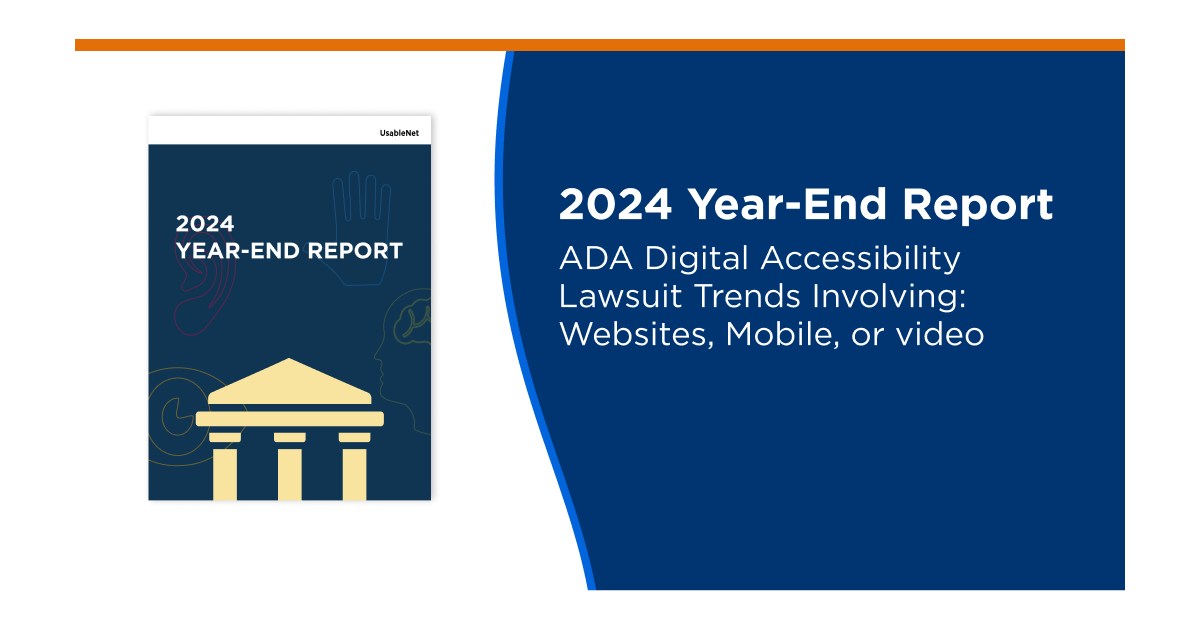This blog follows my post on our 2020 digital accessibility lawsuit report, "A Record-Breaking Year."
Here I consider what those 2020 app and web accessibility trends will have on the future. Below are my predictions for digital accessibility in 2021.
1. ADA lawsuits and demand letters will continue
ADA based lawsuits increased 23% in 2020 to 3500 cases. The practical effect of more lawsuits is more awareness of digital accessibility and more investment.
The other area of legal action is demand letters. It is hard to gauge the volume, but we know they are in the thousands.
Based on conversations with ADA defense law firms, most handle claim letters without plaintiffs filing lawsuits. Claim letters, like lawsuits, drive companies to focus on digital accessibility.
More than 3,000 lawsuits in 2020 shows that plaintiffs and plaintiff firms are very active. Fees can motivate plaintiff firms to file lawsuits. Most companies settle instead of fighting in court.
There are millions of companies who have not done the hard work of digital accessibility. The majority of web sites and app have easy-to-find WCAG violations making it easy for plaintiffs to build a digital accessibility case.
Finally the failure of the proposed Online Accessibility Act Bill there is not immediate change to the legal landscape and could encourage more plaintiff firms to join the small group of leading firms.
2. Pressure on agencies to Deliver App and web accessibility
Many companies that receive a lawsuit outsource their website build. These legal actions will ensure accessibility. Companies will add WCAG clauses to contracts with digital agencies and vendors.
Yet, this is not enough. ADA requires the property owner to be aware and responsible for disability access. Companies should monitor accessibility on an ongoing basis.
Digital agencies may also see the revenue advantages in adding accessibility to their services.
Lawsuits and demand letters state what a company or their agency should be doing to for basic accessibility.
- ADA legal cases often state a blind user could not complete key tasks like check out for retail.
- Plaintiff firm will run automated or manual tests and claim that the website or app has WCAG violation.
- A lawsuit will question a company’s lack of accessibility policy if an accessibility statement is not posted.
Setting up testing, monitoring and remediation around these actions can reduce a company’s risk and help teams prioritize.
User testing and monitoring can be powerful to defend claims. Documentation from digital agencies or internal teams of these activities can provide greater defense against litigation.
3. More Effort to bring guidance for digital to the ADA
The lack of specificity for digital accessibility drives many ADA lawsuits.
Unlike a wheelchair ramp violation, there are no clear standards for digital accessibility in the ADA. Resulting in a digital claim being hard to dismiss at an early stage. A lawsuit often needs to proceed to later stages before a defense can argue it made “adequate accommodation.”
Plaintiff firms often offer settlements in amounts large enough for them to profit but less than it would cost to litigate to these later stages.
Clarifying the standard for digital accessibility sounds easy. But, it could create issues if not done well.
The most recent proposed legislation bill failed in early Jan 20201 called the “Online Accessibility Act”. in part due to lack of support from accessibility advocates. The new legislation would have added a title IV to the ADA, creating a specific set of standards and conditions for web and other digital channels.
The proposed Online Accessibility Act Bill suggested the standard should be WCAG 2.0 AA. The failed bill proposed giving companies a “safe harbor” period to remediate via submission of issues to the DOJ, which many felt to be un-practical for the DOJ to track and enforce.
There are many reasons why this bill did not make it into law. But any future efforts to add technical specification to the ADA will struggle with defining which standards to follow.
The devil will be in the detail.
- WCAG is already at 2.1, not 2.0. There will be at 2.2 during 2021. There is a major update planned in 2023 for WCAG 3.0. With WCAG 3.0, the WC will stand for Web Consortium and not Web Content, to reflect the broader nature of digital.
- Defining compliance with the ADA that all agree on will be a challenge. The WCAG focuses on passing success criteria (38 for WCAG 2.0 AA). Violations, or even missing alternative text off one image, can mean you don't conform to the WCAG and thus ADA.
Companies should make their digital properties accessible. Designing for accessibility and inclusion builds your brand. The social and business benefits are many.
2020 lockdowns confirmed the importance of the online world. Digital is the "new normal" for work, education, finance, food, health and other parts of life.
We should all work to ensure this powerful new digital world benefits everyone. To learn more about inclusive design and other web and app accessibility topics, read my Roadmap to Digital Inclusion.
Additional 2020 recaps and 2021 predictions worth reading
UX Collective - 2021 Accessibility Predictions
Access Defense - 2020 ADA and FHA Retrospective
Accessibility.com - Hot Tech Trends 2021: But Are They Accessible?












